King Kong (1933 film)
| King Kong | |
|---|---|
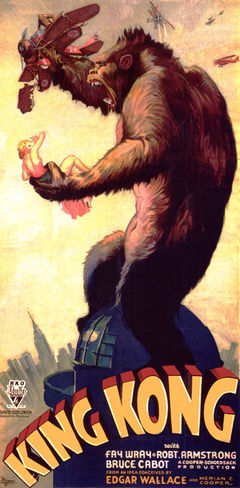 Original theatrical poster |
|
| Directed by | Merian C. Cooper Ernest B. Schoedsack |
| Produced by | Merian C. Cooper Ernest B. Schoedsack David O. Selznick (exec. prod.) |
| Written by | Screenplay: James Ashmore Creelman Ruth Rose Story: Merian C. Cooper Edgar Wallace |
| Starring | Fay Wray Robert Armstrong Bruce Cabot |
| Music by | Max Steiner |
| Cinematography | Eddie Linden J.O. Taylor Vernon Walker |
| Editing by | Ted Cheesman |
| Distributed by | RKO Radio Pictures (Turner Entertainment) |
| Release date(s) | March 2, 1933 |
| Running time | 105 minutes |
| Country | United States |
| Language | English |
| Budget | $500,000 (est.) |
| Gross revenue | $2,000,000 (est.) |
| Followed by | The Son of Kong |
King Kong is a 1933 adventure film co-directed by Merian C. Cooper and Ernest B. Schoedsack, and written by Ruth Rose and James Ashmore Creelman after a story by Cooper and Edgar Wallace. The film tells of a gigantic island-dwelling gorilla-like creature called Kong who dies in an attempt to possess a beautiful young woman. The film stars Fay Wray, Robert Armstrong and Bruce Cabot, and opened in New York City on March 2, 1933 to good reviews. Kong is distinguished for its stop-motion animation by Willis O'Brien and its musical score by Max Steiner. The film has been released to video and DVD, and has been computer colorized.[1] In 1991, the film was deemed "culturally, historically and aesthetically significant" by the Library of Congress and selected for preservation in the National Film Registry.
Contents |
Plot
Ann Darrow (Fay Wray) agrees to star in a film directed by Carl Denham (Robert Armstrong). The two set sail on the S.S. Venture for filming on a mysterious island in the Indian Ocean. During the course of the voyage, Ann falls in love with First Mate Jack Driscoll (Bruce Cabot). The island is reached but the natives kidnap Ann and prepare her as a sacrifice to Kong, a huge gorilla-like creature who dwells on the island. Kong discovers Ann tied to a native altar and carries her to his jungle lair.
Driscoll, Denham, and the crew set out to rescue Ann. They are menaced by dinosaurs, first by a Stegosaurus, and then a Brontosaurus, along the jungle trail and many crew members are killed. Driscoll finds and snatches Ann from Kong's lair but the two are pursued by Kong as they race through the jungle to safety. Kong destroys the native village in his search for Ann. He is finally subdued by hand-tossed gas bombs. Denham returns to civilization with Kong in tow. When Kong is exhibited on the New York stage, he breaks his chains, retakes Ann, and climbs to the top of the Empire State Building. He dies in a hail of machine gun fire from a squadron of military airplanes. Ann is reunited with Driscoll. Below on the street, Denham makes his way through the gathered crowd to look upon the fallen Kong. A police lieutenant says to him, "Well Denham, the airplanes got him." The movie ends with Carl Denham's reply, "No, it wasn't the airplanes... It was Beauty that killed the Beast."
Background
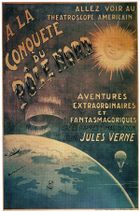
Before King Kong hit the silver screen, a long tradition of jungle films existed, and, whether drama or documentary, such films generally adhered to a narrative pattern that followed an explorer or scientist into the jungle to test a theory only to discover some monstrous aberration in the undergrowth. In such films, scientific knowledge could be turned topsy-turvy at any time and it was this that provided the genre with its vitality, appeal, and endurance.[2]
At the turn-of-the-century, the Lumiere Brothers sent film documentarians to places westerners had never seen, and Georges Méliès utilized trick photography in film fantasies that prefigured that in King Kong. Jungle films were launched in the United States in 1913 with Beasts in the Jungle, a film that mixed live actors with lions, a tiger, and other animals. The film's popularity spawned similar pics including a few about "ape men" and gorillas. In 1918, Elmo Lincoln starred in Tarzan of the Apes,[2] and, in 1925, The Lost World made movie history with special effects by Willis O'Brien and a crew that later would work on King Kong.[3]
Production
Development
Concept
Cooper's fascination with gorillas began with his boyhood reading of Paul du Chaillu's Explorations and Adventures in Equatorial Africa (1861) and was furthered in 1929 by studying a tribe of baboons in Africa while filming The Four Feathers. After reading W. Douglas Burden's The Dragon Lizards of Komodo, he fashioned a scenario depicting African gorillas battling Komodo dragons intercut with artificial stand-ins for joint shots. He then narrowed the dramatis personae to one ferocious, lizard-battling gorilla (rather than a group) and included a lone woman on expedition to appease those critics who belabored him for neglecting romance in his films. A remote island would be the setting and the gorilla would be dealt a spectacular death in New York City.[4]
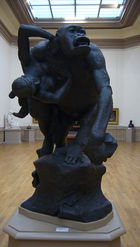
Cooper took his concept to Paramount Studios in the first years of the Great Depression but executives shied away from a project that sent film crews on costly shoots to Africa and Komodo. In 1931, David O. Selznick brought Cooper to RKO as his executive assistant, and, to sweeten the deal, promised him he could make his own films. Cooper began immediately developing The Most Dangerous Game, a story about a big game hunter, and hired his friend and former film partner Ernest Schoedsack to direct. A huge jungle stage set was built and Robert Armstrong and Fay Wray were the picture's stars. Once the film was underway, Cooper turned his attention to the studio's big-budget-out-of-control fantasy, Creation, a story about a group of travelers shipwrecked on an island of dinosaurs. The film had special effects wizard Willis O'Brien on board.[5]
When Cooper screened O'Brien's stop-motion Creation footage, he was unimpressed but realized he could economically make his gorilla picture by scrapping the Komodo dragons and costly location shoots for O'Brien's animated dinosaurs and the studio's existing jungle set. It was at this time Cooper probably cast his gorilla as a giant named Kong, and would have him die at the Empire State Building. The RKO board was wary about the project but gave its approval after Cooper organized a presentation with Wray, Armstrong, and Cabot, and O'Brien's model dinosaurs. In his executive capacity, Cooper ordered the Creation production shelved and put its crew to work on Kong.[6]
Script
Cooper assigned recently hired RKO screenwriter and best-selling British mystery/adventure writer Edgar Wallace the job of writing a screenplay and a novel based on his gorilla fantasy. Cooper understood the commercial appeal of Wallace's name and planned to publicize the film as being "based on the novel by Edgar Wallace". Wallace conferred with Cooper and O'Brien (who contributed, among other things, the "Ann's dress" scene) and began work on January 1, 1932. He completed a rough draft called The Beast on January 5, 1932. Cooper thought the draft needed considerable work but Wallace died on February 10, 1932 just after beginning revisions.[2][7] Cooper insisted however that Wallace died having written "not one bloody word," and that he gave the writer a screen credit simply because as producer he had promised him one.[8]
.jpg)
Cooper called in James A. Creelman (who was working on the script of The Most Dangerous Game at the time) and the two men worked together on several drafts under the title The Eighth Wonder. Some details from Wallace's rough draft were dropped, notably his boatload of escaped convicts. Wallace's Danby Denham character, a big game hunter, became film director Carl Denham. His Shirley became Ann Darrow and her lover-convict John became Jack Driscoll. The 'beauty and the beast' angle was first developed at this time. Kong's escape was switched from Madison Square Garden to Yankee Stadium and (finally) to a Broadway theater. Cute moments involving the gorilla in Wallace's draft were cut because Cooper wanted Kong hard and tough in the belief that his fall would be all the more awesome and tragic.[7]
Time constraints forced Creelman to temporarily drop The Eighth Wonder and devote his time to the Game script. RKO staff writer Horace McCoy was called in to work with Cooper, and it was then that the island natives, a giant wall, and the sacrificial maidens entered the plot. When Creelman returned to the script full time, he hated these 'mythic elements', believing the script already had too many over-the-top concepts. RKO head Selznick and his executives wanted Kong introduced earlier in the film (believing the audience would grow bored waiting for his appearance), but Cooper persuaded them that a suspenseful build-up would make Kong's entrance all the more exciting.[9]
Cooper felt Creelman's final draft was slow-paced, too full of flowery dialogue, weighted-down with long scenes of exposition,[9] and written on a scale that would have been prohibitively expensive to film.[8] Writer Ruth Rose (Mrs. Ernest Schoedsack) was brought in to clean things up and, although she had never written a screenplay, undertook the task with a complete understanding of Cooper's style. She streamlined the script and tightened the action. Rather than explaining how Kong would be transported to New York, for example, she simply cut from the island to the theater. She incorporated autobiographical elements into the script with Cooper mirrored in the Denham character, her husband Schoedsack in the tough but tender Driscoll character, and herself in struggling actress Ann Darrow. She rewrote the dialogue to give it some zip and created the film's entire opening chunk showing Denham plucking Ann from the streets of New York. Cooper was delighted with Rose's script, added the Arab proverb seen on the screen at the beginning, and approved the script (now called Kong) for production.[10] Cooper and Schoedsack decided to co-direct scenes but their styles were different (Cooper was slow and meticulous, Schoedsack brisk) and they finally agreed to work separately with Cooper directing the miniature and special effects scenes and Schoedsack directing the live-action scenes.[11]
Pre-production
Casting
Fay Wray
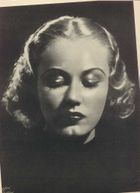
Canadian-born Vina Fay Wray played bit parts in Hollywood until cast as the lead in Erich Von Stroheim's 1928 silent film, The Wedding March. She met Kong co-directors Cooper and Schoedsack when cast as Ethne Eustace in The Four Feathers in 1929. Cooper cast her in 1932 as Eve Trowbridge in The Most Dangerous Game.[12]
After the RKO board approved the Kong test, Cooper decided a blonde would provide contrast to the gorilla's dark pelt. Dorothy Jordan, Jean Harlow, and Ginger Rogers were considered, but the role finally went to Wray who wore a blonde wig in the film and was inspired more by Cooper's enthusiasm than the script to accept the role. Legend says Cooper told Wray he planned to star her opposite the "tallest, darkest leading man in Hollywood". She assumed he meant Clark Gable until he showed her a picture of Kong climbing the Empire State Building.[12]
Wray recorded all her screams in one afternoon session during post-production.[13] She appeared in two other horror films released about the same time as Kong, and, as a result, was labelled a "scream queen" by critics and movie-goers.[14] On the film's 50th anniversary in 1983, one New York theater held a Fay Wray scream-alike contest in its lobby,[15] and, two days after her death on August 8, 2004, the lights of the Empire State Building were dimmed for 15 minutes in her memory.[16]
Robert Armstrong and Bruce Cabot
Michigan native and veteran Broadway and silent film character actor Robert Armstrong played Wray's alcoholic brother in The Most Dangerous Game and, during filming, became a member of the Cooper-Schoedsack inner circle. He was a shoo-in as Denham when Kong was cast.[12] The film's romantic angle (rather than its jungle or animal angle) was played-up after animal films fared poorly at the box office in the early months of 1933. One exhibitor displayed a promotional still of Wray swooning in Armstrong's arms with the caption, "Their Hearts Stood Still...For There Stood Kong! A Love Story of Today That Spans the Ages!". Although the film's romantic subplot belongs to Cabot and Wray, established star Armstrong was chosen for the ad rather than the unknown Cabot.[17] Months later, Armstrong again played Carl Denham in Kong's sequel, The Son of Kong (1933).[18]
New Mexico native Jacques De Bujac was signed by Selznick as a contract player, given the name Bruce Cabot, and met Cooper when auditioning for The Most Dangerous Game. He almost walked out of his Kong audition (mistakenly believing he was trying out as a stunt double for Joel McCrea) but was convinced otherwise and received the role of Jack Driscoll, his first starring role.[19] He was an inexperienced actor and described his participation in Kong as standing in the right place, doing what he was told, and collecting a paycheck.[20]
Other players
German-born Broadway veteran and silent film director Frank Reicher was cast as Captain Englehorn of the SS Venture, Victor Wong as the ship's cook Charlie, James Flavin as Second Mate Briggs, and a host of stuntmen and bit players as the ship's crew. Noble Johnson and Steve Clemente were members of the Cooper-Schoedsack inner circle and cast as the Native Chief and the Witch Doctor respectively while Etta McDaniel played the native girl intended as Kong's bride. Sam Hardy was cast as a theatrical agent and Sandra Shaw (later Mrs. Gary Cooper) was cast as the New York woman Kong drops to the street from the hotel ledge. Cooper played the airplane pilot and Schoedsack the machine gunner in the film's final scenes.[21]
Models
After the RKO board approved the production of a test reel, Marcel Delgado constructed Kong (or the "Giant Terror Gorilla" as he was then known) per designs and directions from Cooper and O'Brien on a one-inch-equals-one-foot scale to simulate a gorilla 18 feet tall. Four models were built: two jointed 18-inch aluminum, foam rubber, latex, and rabbit fur models (to be rotated during filming), one jointed 24-inch model of the same materials for the New York scenes, and a small model of lead and fur for the tumbling-down-the-Empire-State-Building scene. Kong's torso was streamlined to eliminate the comical appearance of the real world gorilla's prominent belly and butt. His lips, eyebrows, and nose were fashioned of rubber, his eyes of glass, and his facial expressions controlled by thin, bendable wires threaded through holes drilled in his aluminum skull. During filming, Kong's rubber skin dried out quickly under studio lights, making it necessary to replace it often and completely rebuild his facial features.[22]
A huge bust of Kong's head, neck, and upper chest was made of wood, cloth, rubber, and bearskin by Delgado, E. B. Gibson, and Fred Reefe. Inside the structure, metal levers, hinges, and an air compressor were operated by three men to control the mouth and facial expressions. Its fangs were 10-inches in length and its eyeballs 12-inches. The bust was moved from set to set on a flatcar. Its scale matched none of the models and, if fully realized, Kong would have stood thirty to forty feet tall.[23]
Two versions of Kong's right hand and arm were constructed of steel, sponge rubber, rubber, and bearskin. The first hand was nonarticulated, mounted on a crane, and operated by grips for the scene in which Kong grabs at Driscoll in the cave. The other hand and arm had articulated fingers, was mounted on a lever to elevate it, and was used in the several scenes in which Kong grasps Ann. A nonarticulated leg was created of materials similar to the hands, mounted on a crane, and used to stomp on Kong's victims.[24]
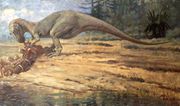
The dinosaurs were made by Delgado in the same fashion as Kong and based on Charles R. Knight's murals in the American Museum of Natural History in New York City. All the armatures were manufacted in the RKO machine shop. Materials used were cotton, foam rubber, latex sheeting, and liquid latex. Football bladders were placed inside some models to simulate breathing. A scale of one-inch-equals-one-foot was employed and models ranged from 18-inches to 3-feet in length. Several of the models were originally built for Creation and sometimes two or three models were built of individual species. Prolonged exposure to studio lights wreaked havoc with the latex skin so John Cerasoli carved wooden duplicates of each model to be used as stand-ins for test shoots and lineups. He carved wooden models of Ann, Driscoll, and other human characters. Models of the Venture, subway cars, and fighter planes were built.[25]
Live-action scenes
King Kong was filmed in several stages over an eight-month period. Some actors had so much time between their Kong periods, they worked other films. Cabot completed Road House and Wray appeared in the horror films, Dr. X and Mystery of the Wax Museum. She estimated she worked ten weeks on Kong over its eight-month period.
In May and June 1932, Cooper directed the first live-action Kong scenes on the jungle set built for The Most Dangerous Game. Some of these scenes were incorporated into the test reel later exhibited for the RKO board. The script was still in revision when the jungle scenes were shot and much of the dialogue was improvised. The jungle set was scheduled to be struck after Game was completed so Cooper filmed all the other jungle scenes at this time. The last scene shot was that of Driscoll and Ann racing through the jungle to safety following their escape from Kong's lair.
In July 1932, the native village was readied while Schoedsack and his crew filmed establishing shots in the harbor of New York City. Fighter planes taking off and in flight were filmed at a U.S. Naval airfield in Brooklyn. Views of New York City were filmed from the Empire State Building for backgrounds in the final scenes and architectural plans for the mooring mast were secured from the building's owners for a mock-up to be constructed on the Hollywood soundstage.[26]
In August 1932, the island landing party scene and the gas bomb scene were filmed south of Los Angeles on a beach at San Pedro, California. All of the native village scenes were then filmed on the RKO-Pathé lot in Culver City with native huts recycled from Bird of Paradise (1932). The great wall in the island scenes was a hand-me-down from DeMille's King of Kings (1927) and dressed up with massive gates, a gong, and primitive carvings. The scene of Ann being led through the gates to the sacrificial altar was filmed at night with hundreds of extras and 350 lights for illumination. A camera was mounted on a crane to follow Ann to the altar. The Culver City Fire Department was on hand to do their job should the set go up in flames from the many native torches used in the scene. Kong's rampage through the village was filmed (again, with hundreds of extras) and filming was completed with individual vignettes of mayhem and native panic.
Meanwhile, the scene depicting a New York woman being dropped to her death from a hotel window was filmed on the soundstage using the articulated hand. At the same time, a scene depicting poker players surprised by Kong's face peering through a window was filmed using the 'big head'; the scene was eventually dropped.[27] When filming was completed, a break was scheduled to finish the interior sets and to allow screenwriter Ruth Rose time to finish the script.
In September and October 1932, Schoedsack returned to the soundstage after completing the native village shoots in Culver City. The decks and cabins of the Venture were constructed and all the live-action shipboard scenes were then filmed. The New York scenes were filmed, including the scene of Ann being plucked from the streets by Denham and the diner scene. Following the interior scenes, Schoedsack returned to San Pedro and spent a day on a tramp steamer to film the Driscoll-slugs-Ann scene and various harbor atmosphere scenes. The Shrine Auditorium in Los Angeles was rented for one day to film the on-stage scenes with Kong in chains and the backstage theater scenes following his escape.[28] Principal photography wrapped at the end of October 1932 with the Driscoll-rescues-Ann scene at the top of the Empire State Building. Schoedsack's work was completed and he headed to Syria to film outdoor scenes for Arabia, a project that eventually remained uncompleted.[29]
In December 1932 and January 1933, the actors were called back to film the optical effects shots which were mostly rear-screen projections. Technical problems inherent in the process made filming difficult and time-consuming. Wray spent most of a twenty-two hour period sitting in a fake tree to witness the battle between Kong and a T. rex. She was sore for days after. Many of the scenes featuring Wray in the articulated hand were filmed at this time. In December, Cooper reshot the New York woman falling to her death scene. Stunt doubles were filmed for the water scenes depicting Driscoll and Ann escaping from Kong. A portion of the jungle set was reconstructed to film Denham snagging his sleeve on a branch during the pursuit scene. Originally, Denham ducked behind a bush to escape danger but this was later considered cowardly and the scene reshot. The final scene was originally staged on the top of the Empire State Building but Cooper was dissatified and reshot the scene with Kong lying dead in the street and a crowd gathered about him.
Post-production
King Kong was settled upon as the title and the film cut from 125 to 100 minutes with scenes that slowed the pace or diverted attention from Kong deleted. Kong's roars and grunts were created by manipulating the recorded roars of zoo lions. For budget reasons, RKO decided not to have an original film score composed but directed composer Max Steiner to simply reuse music from other films. Cooper thought the film deserved an original score and paid Steiner $50,000 to compose it. Steiner completed the score in six weeks and recorded it with a 46 piece orchestra. The studio later reimbursed Cooper.[30]
Spider pit sequence
Legend says a scene depicting miniature sailors and crew members being devoured by a giant spider, a crab, and other creepy crawlies so frightened the first audience it was cut before general release. It is likely however that the scene was cut after an earlier studio screening because it slowed the film's pace and diverted attention from the main plot. The footage was probably destroyed at this time (a general practice of the period), though rumor insists it still exists and is only waiting to be found to this day.[31]
Release
Premieres
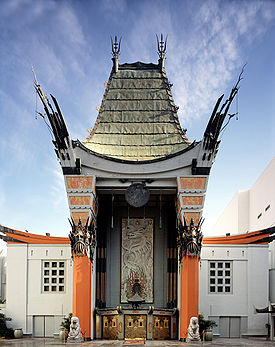
King Kong opened at the 6,200-seat Radio City Music Hall in New York City and the 3,700-seat RKO Roxy across the street on Thursday, March 2, 1933. The film was preceded by a stage show called Jungle Rhythms. Crowds lined up around the block on opening day, tickets were priced at $.35 to $.75, and, in its first four days, every one of its ten-shows-a-day were sold out – setting an all-time attendance record for an indoor event. Over the four day period, the film grossed $89,931.[32]
The film had its official world premiere on March 23, 1933 at Grauman's Chinese Theater in Hollywood. The 'big head bust' was placed in the theater's forecourt and a seventeen-act show preceded the film with The Dance of the Sacred Ape performed by a troupe of African American dancers the highpoint. Kong cast and crew attended and Wray thought her on-screen screams distracting and excessive. The film opened nationwide on April 10, 1933, and worldwide on Easter Day in London, England.[32]
Reception
Variety thought the film a powerful adventure if viewers could get past the machine-like gigantic animals and the phony atmosphere.[33] The New York Times gave readers an enthusiastic account of the plot and thought the film a fascinating adventure.[34] The film's subtextual threat to Aryan womanhood got Kong banned in Nazi Germany.[35] More recently, Roger Ebert thought the effects not up to modern standards, but the film one "that still somehow works."[36] In 2009, King Kong held an average score of 100% "Certified Fresh" based on 46 reviews on Rotten Tomatoes.[37]
Box office
The film made approximately $2 million in its initial release, a big amount in 1933. As a result, RKO saw a profit for the first time in its five year existence. After the 1952 re-release, Variety estimated the film had made $4 million in cumulative domestic rentals for that year.[38]
Awards and honors
Kong did not receive any Academy Awards nominations. Selznick wanted to nominate O'Brien and his crew for a special award in visual effects but the Academy declined. Such a category did not exist at the time and would not exist until 1995. Sidney Saunders and Fred Jackman received a special achievement award for the development of the translucent acetate/cellulose rear screen — the only Kong-related award.[39]
The film has since received some significant honors. In 1975, Kong was named one of the 50 best American films by the American Film Institute, and, in 1991, the film was deemed "culturally, historically and aesthetically significant" by the Library of Congress and selected for preservation in the United States National Film Registry. In 1998, the AFI ranked the film #43 on its list of the 100 greatest movies of all time.[40]
Re-releases
King Kong was re-released for the first time in 1938. Stiffer decency rules had been put into effect in Hollywood since Kong's 1933 premiere and several scenes fell victim to the censor's axe. The scene depicting a Brontosaurus killing sailors in the swamp was trimmed. Scenes completely excised were the "Ann's dress" scene depicting Kong removing Ann's clothing and sniffing his fingers; Kong killing the natives on the village scaffold; and Kong dropping the New York woman to her death from a hotel window. All scenes showing Kong biting or stomping people were cut.[41]
The film was re-released in 1942, 1946, 1952, and 1956 to great box office success. In 1956, censorship rules were relaxed (by that time, the film industry was competing with the television industry for audience numbers and consequently was forced to compromise its principles) and all the film's cut scenes were restored except the "Ann's dress" scene which could not be found. After the 1956 re-release, the film was sold to television and played successfully to huge audiences. In 1969, a print of the "Ann's dress" scene was found in Philadelphia, restored to the film, and re-released to art houses by Janus Films in 1971.[41]
Home media
After being available only on VHS and bootleg DVD releases, King Kong was officially released for the first time to DVD in November 2005, having undergone an extreme restoration process by Warner Brothers. The source for the DVD material was a well-preserved internegative of the film found in the United Kingdom; it also had all censored scenes intact, and a new camera negative of the film was produced to replace the original, which had been destroyed.
Warner Home Video and Turner Entertainment have released the film in a two-disc special edition in regular DVD packaging and in a Collector's Edition featuring both discs in a collectible tin which includes a variety of other printed extras exclusive to the Collector's Edition. As of 2006, the U.S. Special Edition has not been released in the U.K., where only a single disc package is available.
The film was also part of the film colorization controversy in the early 1980s when classic black and white films were colorized for television. In recent years, the colorized version has become highly prized among Kong collectors, despite the fact that the colorization is extremely poor, and there have even been bootleg DVD releases that have appeared on eBay. The colorized version is also available in a Region 2 box set containing the black and white version, the colorized version, King Kong vs. Godzilla (1962) and King Kong Escapes (1967).[42] The Blu-Ray premiered release is set for the 28 September 2010.[43]
See also
- King Kong (1976)
- King Kong (2005)
- List of giant monster films
- List of stop-motion films
- Mighty Joe Young (1949)
- Pre-Code Hollywood
Notes
- ↑ Maltin 738
- ↑ 2.0 2.1 2.2 Peary
- ↑ Morton 21
- ↑ Morton 17-8
- ↑ Morton 18-20
- ↑ Morton 22-5
- ↑ 7.0 7.1 Morton 25-7
- ↑ 8.0 8.1 Goldner (page unknown)
- ↑ 9.0 9.1 Morton 28
- ↑ Morton 28-9
- ↑ Morton 29
- ↑ 12.0 12.1 12.2 Morton 31-3
- ↑ Morton 76
- ↑ Morton 50
- ↑ Erb 31
- ↑ Author unknown (2)
- ↑ Erb 54-5
- ↑ Morton 31-2
- ↑ Morton 32
- ↑ Morton 49
- ↑ Morton 33
- ↑ Morton 33-5
- ↑ Morton 35-6
- ↑ Morton 36
- ↑ Morton 36-8
- ↑ Goldner 173
- ↑ Goldner 165
- ↑ Goldner 159
- ↑ Goldner 185
- ↑ Morton 76-7
- ↑ Morton 63-4
- ↑ 32.0 32.1 Morton 78
- ↑ Bigelow
- ↑ Hall
- ↑ Doherty 293
- ↑ Ebert
- ↑ Author unknown
- ↑ Morton 81,84
- ↑ Morton 81
- ↑ Morton 85
- ↑ 41.0 41.1 Morton 83-4
- ↑ King Kong Collection
- ↑ The Original 1933 King Kong Coming to Blu-ray
References
- American Film Institute (June 17, 2008). "AFI Crowns Top 10 Films in 10 Classic Genres". http://www.comingsoon.net/news/movienews.php?id=46072. Retrieved February 20, 2010.
- [Author unknown] (April 19, 2007). "King Kong (1933)". Rotten Tomatoes. http://uk.rottentomatoes.com/m/1011615-king_kong/. Retrieved February 20, 2010.
- [Author unknown (2)]. "Empire State Building to Dim Lights in Remembrance of Actress Fay Wray". United Press International, Inc.. http://www.upi.com/topic/Fay_Wray/photos/pg-3/. Retrieved February 20, 2010.
- Bigelow, Joe (1933). "King Kong review". Variety. http://www.variety.com/review/VE1117792322. Retrieved February 20, 2010.
- Doherty, Thomas Patrick (1999). Pre-code Hollywood: sex, immorality, and insurrection in American cinema, 1930–1934. Columbia University Press. p. 293. ISBN 0-231-11094-4.
- Ebert, Roger (February 3, 2002). King Kong (1933). Chicago Sun Times. http://rogerebert.suntimes.com/apps/pbcs.dll/article?AID=%2F20020203%2FREVIEWS08%2F202030301%2F1023. Retrieved February 20, 2010.
- Erb, Cynthia Marie (2009). Tracking King Kong: a Hollywood icon in world culture. Detroit, MI: Wayne State University Press. pp. 54–5. ISBN 978-0-8143-3430-0.
- Erish, Andrew (January 8, 2006). "Illegitimate Dad of King Kong". Los Angeles Times. http://pqasb.pqarchiver.com/latimes/access/959395991.html?dids=959395991:959395991&FMT=ABS&FMTS=ABS:FT&type=current&date=Jan+8%2C+2006&author=Andrew+Erish&pub=Los+Angeles+Times&edition=&startpage=E.6&desc=Movies. Retrieved February 20, 2010.
- Goldner, Orville and George E. Turner (1975). The Making of King Kong. Ballantine Books. ISBN 0-498-01519-6.
- Hall, Mordaunt (March 3, 1933). King Kong. New York Times. http://movies2.nytimes.com/mem/movies/review.html?title1=&title2=KING%20KONG%20%28MOVIE%29&reviewer=Mordaunt%20Hall&pdate=&v_id=27391. Retrieved February 20, 2010.
- Haver, Ronald (1987). David O. Selznick's Hollywood. New York: Random House. ISBN 978-0517476659.
- "King Kong Collection". Amazon.com UK. http://www.amazon.co.uk/dp/B000BA8EAW. Retrieved February 20, 2010.
- Maltin, Leonard, ed (2007). Leonard Maltin's 2008 Movie Guide. New York: Signet. ISBN 978-0-451-22186-5.
- Morton, Ray (2005). King Kong: the history of a movie icon from Fay Wray to Peter Jackson. New York, NY: Applause Theatre & Cinema Books. ISBN 1-55783-669-8.
- Peary, Gerald (2004). "Missing Links: The Jungle Origins of King Kong". http://www.geraldpeary.com/essays/jkl/kingkong-1.html. Retrieved February 20, 2010.
External links
- King Kong at the Internet Movie Database
- King Kong at Allmovie
- King Kong at Rotten Tomatoes
- King Kong at Box Office Mojo
- Original Script Note: Differs greatly from final film
|
|||||||||||||||||||
|
|||||||||||